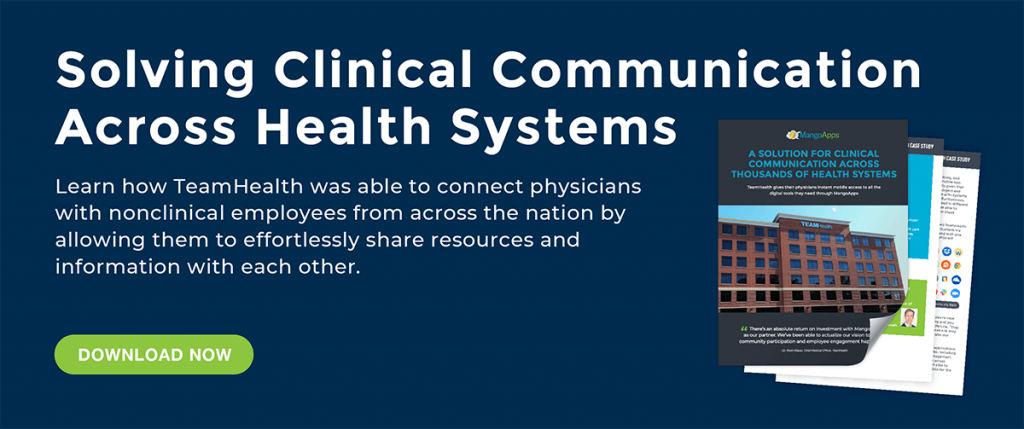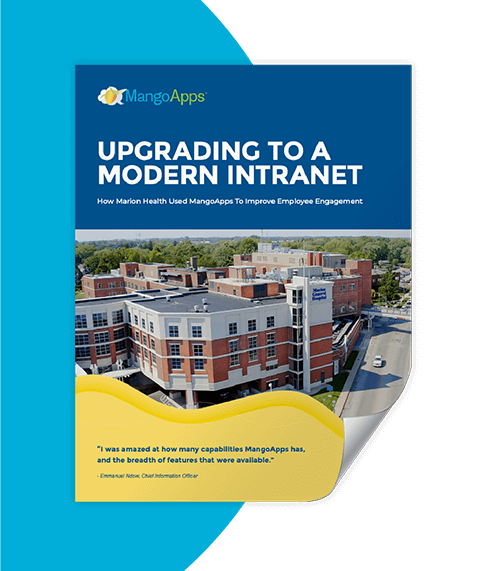In the dynamic realm of healthcare, engagement is not just a buzzword—it’s the lifeblood that fuels a high-performing work environment. Forged in the crucible of relentless shifts, demanding benchmarks, and the overarching aim of patient satisfaction, healthcare employee engagement can empower your system to excel. This guide, tailored for seasoned healthcare administrators, will unveil innovative ideas designed to transform your employee engagement strategies.
As experts in your field, you understand the unique intricacies of the healthcare space; let us provide the insights to invigorate your team and elevate your operations.
Why is Employee Engagement Crucial in Healthcare?
In the dynamic and high-stakes environment of healthcare, where lives are on the line daily, employee engagement ascends beyond traditional notions of job satisfaction or morale. It forms the backbone of an efficient, patient-oriented healthcare system. Engaged employees in healthcare demonstrate greater proficiency in their roles, promote a more collaborative work environment, and directly influence patient satisfaction levels. In fact, fostering engagement is one of the best ways for any health system to reduce burnout.
Highly engaged teams are more likely to exhibit strong communication practices and a deep commitment to their roles, which leads to safer patient handling, minimized medical errors, and improved patient outcomes. Moreover, engagement influences staff retention rates. In an industry where skills shortage is a pressing issue, retaining talent is crucial. Engaged employees feel valued and are less likely to move to competitor organizations, reducing turnover costs and ensuring continuity of care. For more on this, read about reducing nurse turnover.
Further, engaged healthcare employees pave the way for innovative problem-solving and improved operational efficiency. They are more inclined to put forth ideas and suggestions, driving continuous improvement and adaptation in the fast-paced world of healthcare. In essence, employee engagement in healthcare isn’t merely a “nice-to-have,” but a fundamental pillar to healthcare institutions’ success.
As we delve into healthcare employee engagement ideas, it’s important to remember the multifaceted nature of engagement. From technology and software to leadership and culture, numerous factors interact to shape the engagement landscape in the healthcare setting.
The equation is simple: when healthcare employees are engaged, patients are happier. A committed workforce not only elevates patient satisfaction but also directly leads to decreased turnover rates. The ripple effect is evident – a positive, vibrant work environment fosters better healthcare outcomes.
Innovative Healthcare Employee Engagement Ideas
Now that we’ve established the importance of employee engagement in healthcare, let’s explore some ideas that can revolutionize your approach to engaging your workforce. These strategies are designed to drive real results in your organization and do not require any prerequisite technology (although we indicate where and how a healthcare employee app like MangoApps can help).
1. Regular Feedback Systems
A culture of constant communication and transparent feedback is instrumental in fostering engagement and a sense of belonging among healthcare employees. Implementing regular feedback systems can be a game-changer for your organization, encouraging employees to voice their opinions, share insights, and feel heard.
Consider developing two-way feedback systems, where not only can employees receive constructive assessments from their superiors, but they also have the platform to provide their feedback or suggestions. This can serve as an invaluable tool to identify areas of improvement, refine workflows, and inspire innovative solutions.
Expanded Options With Technology
Regular team meetings, one-to-one check-ins or anonymous suggestion boxes are some traditional ways to facilitate feedback. Leveraging digital solutions such as a HIPAA-compliant intranet platform can take this a step further by providing a seamless, real-time channel for feedback, fostering open communication across the organization regardless of shift patterns or physical location.
Moreover, ensure that the feedback is actionable. Nothing disengages an employee more than feeling their feedback is falling on deaf ears. Showcase the direct impact of their suggestions by implementing viable ideas and acknowledging their contributions. This not only validates their efforts but promotes a sense of ownership among employees, encouraging them to remain invested in their roles and the overall growth of the organization.
In essence, a regular feedback system can serve as a key driver of healthcare employee engagement, fostering a culture of openness, ideas, collaboration, and continuous improvement.

2. Creating Space For Cross-departmental Collaboration
Cross-departmental collaboration is another cornerstone to building robust healthcare employee engagement. In the complex, interconnected ecosystem of healthcare, fostering an environment that promotes collaborative efforts across various departments can lead to improved communication, increased innovation, and overall enhanced patient care.
A culture that encourages cooperation across different disciplines and roles helps break down siloes, facilitating a more holistic and comprehensive view of patient care. It enables different teams to leverage their unique insights and expertise, leading to enriched, patient-centered solutions.
For instance, creating interdisciplinary teams for strategic projects or problem-solving tasks can stimulate creativity and innovation. This not only provides a platform for employees to learn and grow, but also drives a sense of camaraderie and mutual respect.
The Role of Training
Additionally, implementing cross-departmental learning sessions can be a powerful tool for facilitating collaboration. These sessions could be opportunities for different teams to share their challenges, victories, and best practices. This not only aids in the exchange of knowledge but also fosters a sense of community and shared purpose.
In the digital age, technology can significantly bolster these collaborative efforts. Platforms like MangoApps offer a suite of tools designed to foster real-time communication, project management, and knowledge sharing across the organization. From real-time messaging and team spaces to collaborative project management tools, these platforms can seamlessly bridge the gap between different departments, fostering a truly interconnected, engaged workforce.
In conclusion, fostering interdisciplinary collaboration can significantly enhance healthcare employee engagement, driving a more integrated, efficient, and patient-centric healthcare system. By breaking down siloes and promoting a culture of collaboration, healthcare organizations can foster a more engaged, satisfied workforce, ultimately leading to improved patient outcomes.
3. Mental Health and Wellbeing Programs
Mental health and wellbeing programs are among the main ideas in fostering healthcare employee engagement. These initiatives are essential in acknowledging the mental and emotional stresses healthcare workers often face in their line of work—many of the signs of physician burnout, for example, fall within this realm. By prioritizing their mental wellbeing, organizations can demonstrate a commitment to their employees, which in turn fosters a sense of loyalty and engagement.
The first step to implementing these programs is to establish a supportive environment that openly talks about mental health. Encourage leaders to be open about the topic, hosting regular discussions, and providing resources that employees can access when they need help. This can greatly reduce the stigma around mental health and make employees feel more comfortable seeking the help they need.
Mental Health Benefits
Next, consider integrating mental health services within your existing healthcare benefits. This could include providing access to therapists or counselors, offering mental health days, or providing resources for self-care practices. By making these resources readily available, you’re sending a clear message to your employees that their mental health matters.
Moreover, consider implementing stress management programs. This could include mindfulness and meditation sessions, yoga classes, or workshops on coping strategies. These programs can equip employees with tools to manage stress and avoid burnout, which is particularly important in the high-pressure environment of healthcare.
Another key aspect is to create a work-life balance. Encourage employees to take time off, restrict overtime, and avoid sending work-related communications during off-hours. This allows employees to recharge and come back to work feeling refreshed and motivated.
Additionally, consider incorporating activities that promote team bonding and camaraderie. Fun activities, team-building exercises, or group wellness challenges can help create a positive work environment and foster a sense of belonging among employees.
Lastly, remember that every member of your workforce is unique. Hence, adopting a one-size-fits-all approach might not yield the desired results. Try to offer a variety of programs and resources to cater to the diverse needs and preferences of your employees.
In conclusion, mental health and wellbeing programs are integral to healthcare employee engagement. By taking proactive steps to support the mental and emotional well-being of employees, healthcare organizations can create a healthier, happier, and more engaged workforce, leading to improved patient care and outcomes.
4. Open Communication Forums
Open communication forums for ideas and concerns are a vital component of healthcare employee engagement. These platforms provide employees with the opportunity to voice their thoughts, ideas, and concerns, fostering an environment of transparency and respect. When employees feel heard, it significantly boosts morale and contributes to a healthier workplace culture.
One of the ways to facilitate open communication is through regular town-hall meetings. These meetings provide a space for employees at all levels to engage in open dialogue about the organization’s direction, challenges, and successes. They also serve as a platform for leadership to address the concerns and queries of the staff, reinforcing transparency.
In addition to town-hall meetings, having an open-door policy can significantly contribute to open communication. This policy encourages employees to communicate freely with management without fear of repercussions. It promotes trust and demonstrates to employees that their opinions are valued, which can greatly increase employee engagement.
Promote Psychological Safety
Similarly, implementing suggestion boxes or online feedback forms can provide employees with a confidential avenue to voice their thoughts and ideas. This can be particularly effective for those who feel uncomfortable expressing their views in public settings. It’s key to ensure that every suggestion is reviewed and feedback is provided to demonstrate that every voice matters.
Moreover, digital communication platforms like MangoApps can be leveraged to foster open communication. These platforms allow real-time communication and collaboration, providing employees with a sense of connection and cohesion. They also offer features like forums or channels for specific topics, allowing for focused discussions and idea sharing.
In conclusion, open communication forums play a pivotal role in fostering healthcare employee engagement. By creating a culture of transparency and respect, organizations can improve employee satisfaction, efficiency, and overall organizational performance.
5. Mentorship Programs
Mentorship programs are a powerful tool in promoting healthcare employee engagement. These programs pair less experienced employees with more seasoned colleagues, fostering an environment of learning, professional growth, and mutual respect. Mentors provide guidance, share experiences, and offer constructive feedback, helping mentees navigate the complexities of the healthcare industry.
The first step in establishing a successful mentorship program is to identify potential mentors. Look for employees who demonstrate leadership qualities, have a wealth of experience in their respective fields, and possess a willingness to guide others. Equally important is ensuring that mentors understand their role and responsibilities – they’re not just supervisors, but coaches and facilitators.
Similarly, it’s crucial to match mentors with the right mentees. This should not be random; instead, consider factors like career goals, skills needs, and personality traits. A good match can lead to more productive relationships and better outcomes for the program.
Setting Clear Expectations
Once pairs have been established, it’s essential to set clear expectations for the mentor-mentee relationship. This might include establishing regular meeting times, setting goals for the program, and laying out what each party should expect from the other. Providing a clear structure can help ensure that both parties benefit from the mentorship.
It’s also important to provide ongoing support for the mentorship program. This might include regular check-ins with mentors and mentees, providing resources for mentors, or offering training sessions to help mentors enhance their mentoring skills. Fostering a supportive environment increases the chances of a successful and impactful mentorship experience.
To make your mentorship program even more engaging, consider implementing a recognition program. Recognizing the hard work and commitment of mentors and mentees can motivate participants and make them feel appreciated. This could be as simple as a shout-out in a company meeting, a certificate of recognition, or a small token of appreciation.
Moreover, it’s crucial to evaluate the effectiveness of your mentorship program regularly. This can be done through surveys, feedback sessions, and tracking the progress of mentees. Collecting and analyzing this data can provide valuable insights into what’s working, what’s not, and where improvements can be made.
In conclusion, mentorship programs are a powerful strategy for fostering healthcare employee engagement. They create an environment of learning and growth, improve job satisfaction, and lead to a more skilled and competent healthcare workforce. By investing in these programs, healthcare organizations can enhance employee engagement, improve patient care, and boost overall organizational performance.
6. Recognition and Reward Systems
Recognition and reward systems are another essential aspect of healthcare employee engagement. Recognizing employees for their hard work, dedication, and achievements can significantly boost morale, increase job satisfaction, and foster a positive work culture.
The first step in implementing an effective recognition and reward system is to identify what behaviors, values, or accomplishments should be rewarded. These could range from surpassing performance targets, displaying exceptional patient care, showing teamwork, or demonstrating a commitment to continuous learning. By rewarding these behaviors, you reinforce the values you want to see throughout your organization.
Next, it’s important to diversify the types of recognition and rewards. Not all rewards have to be monetary. Recognition can come in many forms, from a simple thank you note to a spot in the company newsletter or a shout-out in a team meeting. Similarly, rewards could be as simple as an extra day off, a gift card, or a flexible work schedule. The key is to make the reward meaningful to the individual.
Real-Time Recognition
Moreover, instant recognition can be highly effective. Rather than waiting for a formal review, acknowledging an employee’s achievement in the moment or soon after can make the recognition more impactful. Real-time recognition platforms, such as MangoApps, can be particularly beneficial for this, providing a visible, immediate, and memorable way to celebrate achievements.
In addition to individual recognition, consider implementing team or department recognition. Celebrating team successes can foster a sense of unity and collaboration, promoting a positive work culture.
Lastly, it’s crucial to ensure that recognition and rewards are fairly distributed. All employees, regardless of their role or level, should have the opportunity to be recognized for their contributions. This promotes a sense of fairness and inclusivity, which can greatly enhance employee engagement.
In conclusion, an effective hospital recognition program can work wonders for healthcare employee engagement. By acknowledging and appreciating the hard work and dedication of your employees, you can foster a positive, engaging, and productive work environment.
Acknowledging milestones and standout employees is critical. With technology, not only can we streamline this recognition, but we can also empower peers to commend each other. When recognition is linked with tangible rewards, motivation skyrockets.

Enabling clinical staff at Marion Health
Learn how Marion Health improved communication and collaboration among staff and clinicians with a secure employee app.
7. Feedback Loops
Feedback loops are vital to ensuring ongoing healthcare employee engagement. They provide employees with a platform to voice their thoughts, opinions, and suggestions, fostering a sense of involvement and ownership over their roles. Moreover, feedback loops allow for continuous improvement, as employees are often the best source of ideas for enhancing workflow, patient care, and overall organizational performance.
The first step in creating an effective feedback loop is to establish a culture of open communication. Encourage employees to speak up and share their thoughts without fear of retaliation. This can be done by promoting a non-judgmental environment where all feedback, whether positive or negative, is appreciated and valued.
Next, provide various channels for feedback. This could include regular one-on-one meetings with supervisors, anonymous suggestion boxes, digital platforms, or town hall meetings. Providing multiple avenues ensures that all employees, regardless of their comfort level, have an opportunity to voice their thoughts.
Acknowledging Feedback Is Crucial
Once feedback is collected, it’s crucial to acknowledge it. Employees need to know that their feedback has been heard and is being considered. This could be done through a personal response, a general announcement, or a demonstration of action taken as a result of the feedback.
Acting upon the feedback is, however, the most critical aspect of a feedback loop. While it may not be possible to implement all suggestions, showing that some changes are made based on employee input can significantly boost engagement. If a suggestion cannot be implemented, explaining the reasons can maintain trust and transparency.
Feedback should also be a two-way street. Managers should provide employees with regular feedback about their performance, offering praise for achievements and constructive advice for areas of improvement. This helps employees understand their strengths, areas for growth, and the impact of their work, contributing to their engagement and job satisfaction.
Finally, the effectiveness of the feedback loop should be regularly reviewed. This could involve surveying employees about their satisfaction with the feedback process or analyzing whether implemented changes have led to improvements.
In conclusion, feedback loops are an integral part of healthcare employee engagement. They involve employees in decision-making, promote continuous improvement, and demonstrate that the organization values its employees’ input. By prioritizing feedback, healthcare organizations can improve their operations, boost employee morale, and ultimately, deliver better patient care.
Employing user-friendly platforms such as MangoApps can greatly simplify the feedback process. These platforms allow for easy collection, analysis, and actioning of employee feedback, enhancing the effectiveness of feedback loops.
Implementing These Ideas in Your Health System
To adopt these healthcare employee engagement ideas in your health system, it is necessary to take a holistic approach, focusing on both the individual and collective needs of your team. Here’s a step-by-step guide on how to develop your own engagement program:
1. Understand your current state
Before you can plan improvements, you need to understand the current state of employee engagement in your health system. Use tools like employee surveys, focus groups, and one-on-one interviews to gather insights about what’s working well and where improvements can be made. You’ll want to probe into areas such as communication, recognition, feedback, leadership, job satisfaction, and work-life balance. Using tools like MangoApps can help streamline this process, making it easier to collect and analyze employee feedback.
2. Develop a clear vision
Developing a clear vision is a critical step in implementing effective healthcare employee engagement strategies. Begin by defining what employee engagement looks like in your organization and the outcomes you hope to achieve. Your vision should be inspiring, achievable, and aligned with your organization’s values and goals. It may include elements such as open communication, regular feedback, recognition of employees’ efforts, opportunities for professional development, and a positive work environment.
To ensure the vision is holistic and encompasses the multifaceted nature of healthcare, involve leadership from multiple functions. Leaders from operations, HR, nursing, medicine, and support services should all have a seat at the table. Harnessing their unique perspectives will help you create a comprehensive vision that caters to the diverse needs of your workforce.
Remember, the vision should be communicated clearly and consistently to all employees. This not only ensures everyone is on the same page but also reinforces the importance of employee engagement in achieving organizational success. Using an integrated platform like MangoApps can aid in this communication process, providing an easy-to-use channel for conveying your vision and other important updates.
Once the vision is established, it should serve as the north star guiding all your employee engagement initiatives. Always refer back to this vision when planning activities or making decisions to ensure alignment and consistency. This will help to create a cohesive and engaging experience for your employees, reducing burnout and improving satisfaction and ultimately, patient care.
3. Create an action plan
With your vision in place, you can start developing a detailed action plan. This plan should outline the steps you’ll take, the resources you’ll need, and the timeline for implementation. It should also specify how you’ll measure success. Remember to incorporate various healthcare employee engagement ideas into your plan, ensuring it addresses the diverse needs and preferences of your team.
4. Communicate and implement the plan
Once your action plan is ready, it’s time to communicate it to your team. Remember, communication should be a two-way street. Invite feedback and be ready to make adjustments based on the responses you receive. Then, start implementing your plan. Tools like MangoApps can support you in this phase, helping you manage tasks, track progress, and facilitate communication.
5. Evaluate and adjust
Engagement is a continuous process that requires regular evaluation and adjustment. Schedule times to review your progress, celebrate wins, and brainstorm solutions to challenges. Use employee feedback, engagement metrics, and other relevant data to assess the effectiveness of your plan. Be ready to make necessary adjustments and continually refine your approach. This constant cycle of feedback and improvement can keep your engagement efforts fresh and effective, helping you achieve your goals.
Remember, every health system is unique, so it’s essential to customize your engagement strategy to best fit your organization’s specific needs and circumstances. Both macro and micro-level initiatives can have a significant impact on engagement levels, so be sure to address both broad organizational changes as well as individual employee needs. Lastly, remember that building engagement is a long-term process that requires consistent effort, commitment, and patience.
Conclusion
The heart of any healthcare system is its employees. By championing their well-being, promoting open communication, and acknowledging their achievements, we pave the way for improved healthcare outcomes. The future of healthcare is intertwined with engaged employees.
For more on this topic, read about reducing nurse turnover, physician engagement strategies, or digital transformation in healthcare.







